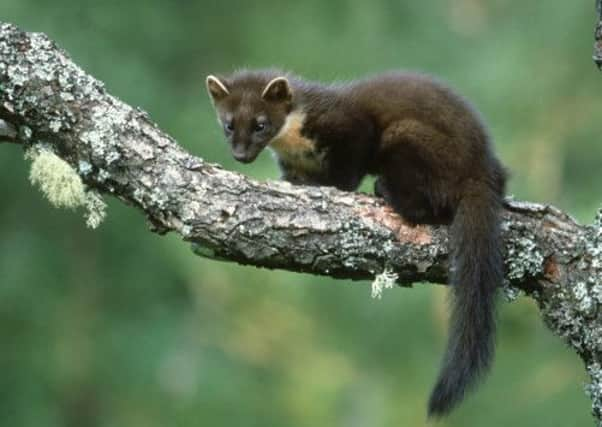Welcome predator: Red squirrels have an ally – the once scarce pine marten


Shortly afterwards we came to a magnificent viewpoint looking eastwards over the broad expanse of the central belt of Scotland. As we gazed across the patchwork panorama of fields and towns crowned by Stirling Castle in the far distance, I couldn’t help but feel incredulous that this fascinating predator, once dubbed one of our rarest mammals was now within touching distance of our main population centres. It would, I mused, surely be only a matter of time before it recolonised our southern lowland areas.
As it turns out, this recolonisation was probably already well underway even as I surveyed the horizon before me, with a new joint survey by Scottish Natural Heritage and the Vincent Wildlife Trust revealing that the pine marten now occurs in lowland areas from which it has been absent for more than 100 years, including much of Stirlingshire and parts of Fife and the central belt. It has also moved into Caithness, Moray, Perth and Kinross, Aberdeenshire and Angus.
Advertisement
Hide AdAdvertisement
Hide AdPine martens, which are members of the weasel family and slightly larger than a ferret, are largely nocturnal and hard to spot, but their droppings are often deposited on paths and other prominent places. In the summer of 2012 surveyors collected possible pine marten droppings on woodland tracks and paths in an “expansion zone” mainly to the east and south of the marten’s previously known range. Using DNA analysis so as to prevent confusion with fox scat, it was possible to build up an accurate picture of pine marten distribution and the extent it is expanding into new areas.
The pine marten had been declining for some considerable time due to habitat loss caused by woodland felling, which was further hastened by direct human persecution. By the early 1900s the pine marten was largely confined to the north-west Highlands when it is estimated that there may have been as few as 1,500 animals left in Scotland, with much smaller population pockets in northern England and Wales. But in recent decades its fortunes began to turn and the range gradually expanded, boosted by reforestation and reduced persecution since the pine marten was afforded full legal protection in 1988.
One of the most intriguing aspects of this expansion is the implication it may have for the grey squirrel – a native of eastern North America that was introduced into Britain in the late 19th and early 20th centuries and which has spread throughout much of southern and eastern Scotland. The grey has been largely blamed for the contraction in range of our own native red squirrel due to their ability to dominate them. Greys also carry squirrel pox which does not harm them but can kill reds.
This relentless onward march of the grey might seem hard to halt, but pine martens prey upon squirrels – so could this agile predator play a role in helping save our iconic red squirrel populations?
Research from Ireland suggests this could well be the case. Scientists from the National University of Ireland in Galway have recorded a decline in grey squirrel populations and an increase in red squirrel numbers in certain midland counties of the country where pine martens now thrive. Dietary analysis also showed that the martens regularly ate grey squirrels but not reds. Researchers speculate that this could be because grey squirrels are less agile than red squirrels, spending much of their time on the ground foraging for food, thus making the animal a relatively easy target. In contrast, the nimble red squirrel is harder to catch as it spends a lot of the time in the tree canopy. Irish scientists believe it is also possible that the presence of pine martens upsets grey squirrels’ feeding habits, breeding and overall sense of security, contributing to their overall decline.
It is too early to say what impact, if any, the pine marten will have on grey squirrels in Scotland and greys will certainly continue to prosper in our parks and towns and many other parts of the country. But in those frontline areas where grey and red squirrel populations overlap, the red may well have the most unlikely ally in its battle for survival.